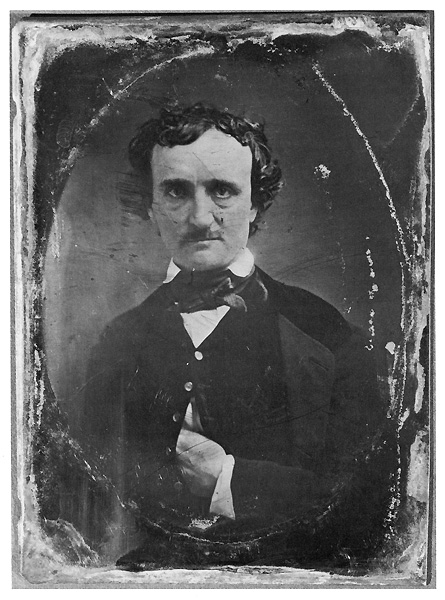Of course I shall not pretend to consider it any matter of wonder, that the extraordinary case of Edgar Allan Poe has excited discussion. It would have been a miracle had it not—especially under the circumstances. Though the desire of all parties concerned, to bring the affair to the public, at least for the present, or until we had further opportunities for investigation–through our endeavors to effect this—a garbled or exaggerated account made its way into society and became the source of many unpleasant misrepresentations, and, very naturally, of a great deal of disbelief.
It is now rendered necessary that I give the facts—as far as I comprehend them myself. They are succinctly, these:
Edgar Allen Poe, poet and father of the detective story, was living in New York in 1849. On September 27, he left Richmond, VA, to go to Philadelphia, PA, to edit poetry for Mrs. St. Leon Loud. On October 3, a rainy Election Day, Baltimore Sun compositor (typesetter) Joseph W. Walker found Poe lying outside of a polling place. The author was delirious, immobile, and wearing someone else’s clothes. Seeking assistance, Walker was able to pry a name from Poe: Joseph E. Snodgrass, a local editor with some medical knowledge. Walker wrote a brief letter.
Baltimore City, Oct. 3, 1849
Dear Sir,
There is a gentleman, rather the worse for wear, at Ryan’s 4th ward polls, who goes under the cognomen of Edgar A. Poe, and who appears in great distress, & he says he is acquainted with you, he is in need of immediate assistance.
Yours, in haste,
JOS. W. WALKER
To Dr. J.E. Snodgrass.
Dr. John J. Moran attended to Poe at Washington Medical College. Poe died there on October 7 with a diagnosis of congestion of the brain or cerebral inflammation. He had been observed in the three previous days hallucinating and calling out for “Reynolds,” whose identity remains unknown. The death certificate and medical records have not been found.
It came to be explored that Poe succumbed to rabies. Dr. R. Michael Benitez participated in a 1996 exercise in which he was asked to diagnose an unknown patient E.P. who displayed lethargy, delirium, visual hallucinations and panting. He found it to be a textbook case of rabies. The diagnosis found approval from Jeff Jerome of the Poe House Museum in Baltimore. “This is the first time since Poe died that a medical person looked at Poe’s death without any preconceived notions.” The theory was popular enough to lend itself to the title of a 1997 double CD of Poe readings called Closed on Account of Rabies featuring Debbie Harry, Iggy Pop, and Christopher Walken.
On the other hand, Poe may have been subject to cooping. Hired gangs kidnapped their victims, dressed them in other clothes and forced them to vote for a candidate at multiple polling under assumed identities. This would explain the strange clothes.
Alcohol may have played a strange role in the turn of events. Poe was likely to have had a hereditary condition that rendered him drunk off of as little as a glass of wine. In the 1800s, drinks were offered to voters. If coopers dragged Poe through the polls, the copious alcohol may have led to his delirious state. The fatal diagnoses of congestion of the brain and cerebral inflammation were code words for death by alcoholism.
This would have played into the hands of Poe’s nemesis, Rufus Wilmot Griswold. The poetry anthologist held a feud against Poe. On October 9, under the pseudonym Ludwig, Griswold published and obituary in the New York Tribune. “Edgar Allan Poe is dead. He died in Baltimore the day before yesterday. This announcement will startle many, but few will be grieved by it.” Griswold became Poe’s literary executor, and used the position and the unproven death by alcoholism to tarnish reputation of the master of the macabre.
While this would have fit motives for a detective story, another mystery followed Poe from beyond the grave. Beginning in the 1930s, a figure clad in black, a wide-brimmed hat and a white scarf visited Poe’s grave on his birthday, January 19. Each year, the Poe Toaster saluted the grave with a glass of cognac, and left the bottle along with three roses. The final visitation occurred on January 19, 2009, the author’s bicentennial. The Toaster’s identity has never been verified.
For what really occurred surrounding the death of Edgar Allan Poe, however, it is quite impossible that any human being could have been prepared.
[Portions of this piece were appropriated from Poe’s The Facts in the Case of M. Valdemar.]


There are no voices yet... Post-script us a message below, won't you?